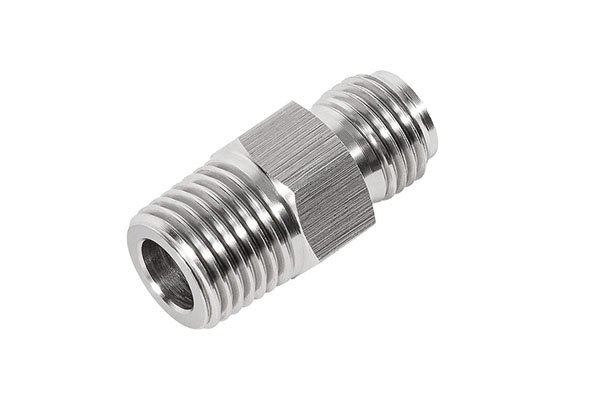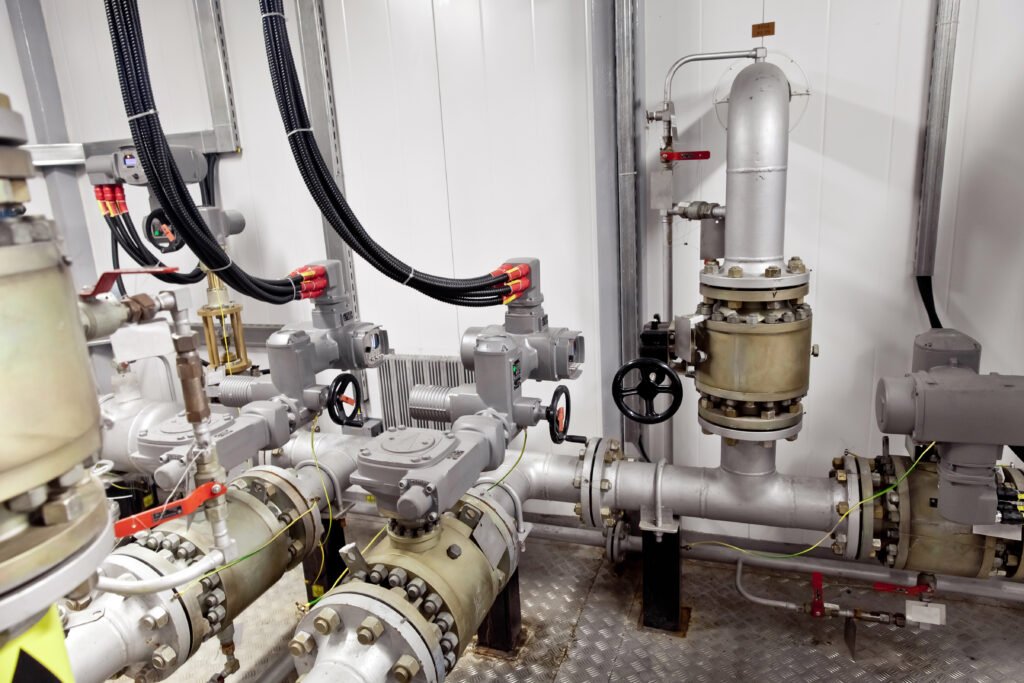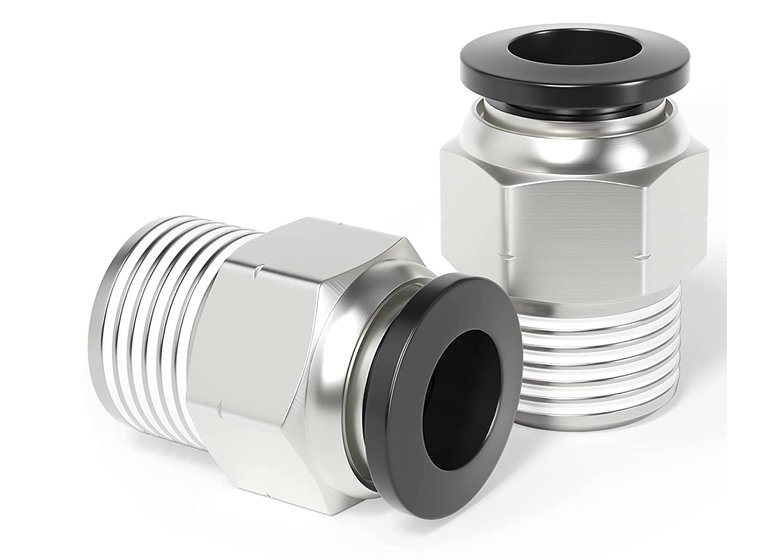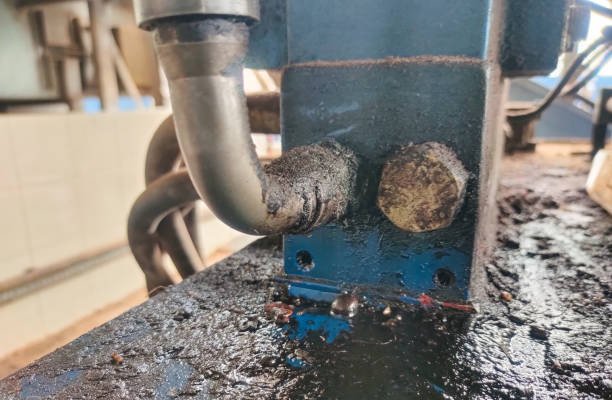Understanding NPT Fittings
What Are NPT Fittings?
NPT, or National Pipe Tapered thread fittings, are a staple in many fluid and gas transfer systems across industrial sectors. Their design is based on a tapered thread geometry, where the male and female threads wedge together, creating a seal as torque is applied. The seal is dependent on both mechanical interference and, in most cases, supplemental sealing materials such as PTFE tape or pipe dope.
What makes NPT fittings popular is their ease of use and availability. You’ll find them in plumbing systems, gas lines, hydraulic applications, and even in some pneumatic circuits. Their tapered design enables fast installation without the need for specialized equipment, which appeals to many field technicians and system integrators.
However, the same taper that allows for a pressure-tight seal in static systems becomes a point of vulnerability in dynamic, high-vibration environments.

Key Features and Common Uses
Key technical attributes of NPT fittings include:
- Taper angle: 1°47′24″ on each side, helping create a compression seal.
- Thread engagement: 60-degree thread angle with varying depth, limiting reusability.
- Pressure rating: Typically suitable for moderate-pressure environments, though it varies by material and application.
Common applications:
- Water supply lines
- Low-vibration hydraulic control panels
- Pneumatic systems in fixed installations
- Oil and fuel pipelines in static environments
Despite their convenience, they are not self-locking, nor designed to resist cyclic loading, which is critical in vibratory systems.
High-Vibration Environments Explained
Industries with High-Vibration Machinery
In certain industries, equipment operates under conditions where vibration is not incidental, but constant and severe. This includes:
- Mining & Quarrying: Equipment like crushers, screeners, and conveyors vibrate continuously during operation.
- Aerospace & Aviation: Aircraft systems experience multi-directional vibration during takeoff, landing, and turbulence.
- Automotive & Rail: Engine compartments and suspensions expose components to rotational and road-induced vibrations.
- Marine & Offshore: Vessel engines and wave forces lead to mechanical oscillations.
- Manufacturing & Robotics: High-speed actuators and stamping equipment create micro and macro-level vibrations.
These applications place significant cyclical stress on every connection point, especially those with rigid thread-based seals.
How Vibration Affects Mechanical Components
Vibration acts as a dynamic load, continually shifting the contact points within threaded assemblies. Over time, this causes:
- Fretting wear on threads
- Loss of preload (the force maintaining the seal integrity)
- Thread distortion or creep
- Separation of mated components, leading to leaks or catastrophic failure
In NPT fittings, these effects are magnified because the seal relies entirely on tight thread engagement, not a mechanical stop or locking feature. Unlike compression or flare fittings, there’s no inherent resistance to vibrational loosening.
Design Limitations of NPT Fittings
Threaded Sealing Challenges
NPT fittings rely on the deformation of metal threads to achieve a seal. This makes them sensitive to:
- Over-tightening, which can strip threads or crack fittings (especially in brass and plastic)
- Under-tightening, which results in leaks
- Thread quality variations, where even a slightly defective pitch can compromise the seal
Vibration compounds all of these risks by introducing micro-motion between mating surfaces, eventually leading to seal failure.
Vibration-Induced Loosening
NPT threads were never engineered with anti-vibration in mind. Without a locking mechanism, fittings loosen over time due to:
- Axial and torsional motion from equipment
- Expansion/contraction cycles from temperature changes
- Uneven loading on support brackets or connected hoses
The result is an increase in fitting maintenance, and often, progressive system degradation that goes unnoticed until pressure loss or fluid leakage becomes apparent.
Risk of Leakage and Maintenance Concerns
Even when initial installation is perfect, vibration slowly unravels the integrity of NPT seals. Key concerns include:
- Hidden leaks: Small leaks may escape detection during routine checks, leading to contamination or pressure imbalance.
- Cost of rework: Every leak demands system shutdowns, increased labor, and potential fluid loss.
- Safety risks: In hydraulic or gas systems, pressurized leaks can cause fires, component failures, or even injury.
Because these fittings lack a predictable failure mode, they often fail silently, creating risk scenarios that are difficult to monitor without advanced sensors or inspections.
Why NPT Fittings May Fail in Vibratory Conditions
Thread Galling and Fatigue
Galling is a form of adhesive wear that occurs when two metal surfaces slide against each other under pressure. In NPT fittings, which rely on metal-to-metal contact to create a seal, thread galling becomes a significant issue, particularly in stainless steel fittings.
In high-vibration environments:
- The continual micro-movement at the thread interface promotes galling.
- Once galling starts, threads may weld together microscopically and then tear apart under further motion or disassembly attempts.
- The result is irreparable damage to both the male and female threads, rendering the fitting unusable and potentially damaging the equipment it’s connected to.
Moreover, the cyclic nature of vibration leads to metal fatigue in the threads themselves. Threaded regions begin to weaken from repetitive stress, increasing the chance of cracking or complete fracture.
Torque Loss Over Time
Another critical issue is loss of torque preload. When an NPT fitting is installed, torque is applied to compress the threads and create a seal. Over time, vibration causes:
- Thread relaxation: Slight shifts in metal-to-metal contact that reduce compressive forces.
- Settling of materials: Especially in systems where PTFE tape or anaerobic sealants were used, these materials can compress under stress, reducing initial tightness.
- Thermal cycling effects: In heated environments, expansion and contraction further loosen the fitting.
This gradual torque decay means that even if a fitting passes an initial pressure test, it can fail hours, days, or weeks later under field conditions.
Compatibility Issues with Dynamic Systems
NPT fittings are inherently rigid and static by design. In contrast, dynamic systems require components that:
- Flex or pivot slightly with motion
- Absorb or redirect forces without transferring them directly to the seal
- Tolerate misalignment or movement without losing integrity
Because NPT fittings lack such features, they are frequently mismatched to systems with:
- Moving actuators or rotating assemblies
- High-pressure pulsations or surges
- Dynamic loading conditions (e.g., mobile or transport-based systems)
In these cases, NPT becomes a point of failure, necessitating a more adaptable connection method.
Alternative Fitting Solutions
Compression Fittings
Compression fittings offer a mechanically reliable and leak-resistant solution in environments subject to vibration. These fittings work by:
- Sliding a ferrule over the tubing
- Compressing the ferrule into the fitting body using a nut
- Creating a metal-to-metal seal independent of thread deformation
Benefits include:
- Superior vibration resistance
- Reusability without thread degradation
- Ease of installation without torque-critical steps
They are commonly used in instrumentation panels, process controls, and gas delivery systems.
Flare and Bite-Type Fittings
These fittings use a cone-shaped seat and a flared tube end or a biting ferrule to form a secure mechanical grip. Examples include:
- 37° JIC flare fittings (common in hydraulics and aviation)
- DIN bite-type fittings (used in European and mobile hydraulic systems)
Advantages:
- Withstand extremely high pressures
- High cycle fatigue tolerance
- Excellent vibration resistance without retightening
The key here is geometry—flare angles and bite edges create self-reinforcing seals under pressure, something NPT cannot offer.
Welded Connections
For systems where zero leakage and permanent reliability are essential (such as in chemical plants or aircraft), welded joints are preferred. They eliminate the risk of:
- Thread loosening
- Seal degradation
- Corrosion within fitting threads
Welded tubing or pipe is immobile and fully integrated, making it immune to vibration-based failure—though it comes with higher installation cost and less flexibility for reconfiguration.
Comparing NPT vs. Vibration-Resistant Fittings
To help engineers and technicians make informed choices, here’s a side-by-side comparison:
| Feature | NPT Fittings | Compression/Flare/Bite-Type |
|---|---|---|
| Vibration Resistance | Poor | Excellent |
| Seal Reliability Over Time | Degrades quickly | Stable under vibration |
| Reusability | Low (threads wear) | High (ferrules or flares remain intact) |
| Ease of Installation | Moderate (torque sensitive) | High (less torque critical) |
| Risk of Galling/Thread Damage | High in stainless or reused threads | Very low |
| System Downtime for Leaks | Frequent | Rare |
| Initial Cost | Low | Medium to High |
| Total Cost of Ownership | High due to failures | Lower with long-term use |
The long-term savings in reduced maintenance, leak prevention, and system reliability make vibration-resistant fittings a superior investment in most industrial settings.
Case Studies from Industry Applications
Failures of NPT in Hydraulic Systems
A large-scale mining operation in South Africa experienced repeated hydraulic leaks on a crusher’s control system. The fittings used were standard stainless steel NPT connections. Despite using anaerobic thread sealants and routine torque checks, the fittings began to loosen after just two weeks of operation.
A failure analysis revealed:
- Micro-movement between threads due to vibratory stress
- Thread wear and galling, especially in reused fittings
- Systemic pressure loss, leading to actuator misfire
Once the site switched to 37° flare fittings with swivel nuts, the leak incidents dropped to zero, and maintenance intervals extended from two weeks to three months. The switch paid for itself within six months through reduced downtime and labor.
Successful Switchover to Alternative Fittings
In a U.S.-based packaging plant, NPT fittings were used in a compressed air system on high-speed robotic arms. Vibration from the actuation cycle caused hairline leaks that were invisible to the naked eye but registered on the PLC’s pressure monitoring system.
Replacing the NPT connections with compression fittings equipped with vibration-resistant ferrules yielded the following:
- Improved pressure consistency
- Elimination of minor air losses
- Decreased compressor load by 8%, saving energy
This not only enhanced production efficiency but also contributed to a 15% reduction in operating costs over the next fiscal year.
Best Practices for High-Vibration Fluid Systems

Choosing the Right Connection Type
When selecting fittings for a system exposed to vibration, engineers should consider the following hierarchy (from least to most vibration-resistant):
- NPT fittings – only acceptable in static conditions
- Threaded straight fittings with O-rings – better sealing but still rigid
- Compression fittings – ideal for medium vibration
- Flare fittings – excellent mechanical grip under cyclic loads
- Welded tubing – best for critical and high-vibration systems
Tip: Don’t mix fitting types in the same vibration zone. Doing so may introduce uneven stress across the piping network.
Regular Inspection and Torque Checks
Even with vibration-resistant fittings, regular preventive maintenance is essential. Guidelines include:
- Monthly inspections in mobile or heavy-duty environments
- Torque verification using calibrated wrenches
- Non-destructive testing (NDT) for critical joints (e.g., ultrasonic or dye-penetrant methods)
Keep a log of torque values and date of installation for future reference—this data can help track wear trends and predict future issues.
Use of Thread Sealants and Locking Compounds
For systems where NPT fittings cannot be replaced immediately:
- Use medium-strength anaerobic thread lockers specifically rated for hydraulic and fuel systems (e.g., Loctite 545).
- Avoid over-reliance on PTFE tape, which can degrade or migrate over time.
- Always follow manufacturer recommendations for sealant cure times and torque values.
However, no sealant can permanently prevent loosening under continuous vibration. These should be treated as interim solutions.
Industry Standards and Recommendations
ASME and SAE Guidelines
Both ASME (American Society of Mechanical Engineers) and SAE (Society of Automotive Engineers) have published standards outlining best practices for fittings and connections:
- ASME B1.20.1: Details the geometry and limits for NPT thread profiles.
- SAE J514: Specifies requirements for 37° flare fittings, including performance under pressure and vibration.
- SAE J1453 (ORFS): Outlines O-ring Face Seal fittings, designed for zero-leak performance in hydraulics.
These documents clearly indicate that NPT threads are only suitable for low-vibration, static applications and that flare, ORFS, or compression fittings are preferred for dynamic systems.
Manufacturer Specifications
Leading manufacturers like Swagelok, Parker Hannifin, Taske and Eaton have comprehensive documentation showing:
- Maximum recommended vibration levels
- Compatible sealing materials for various media
- Installation torque and reassembly limits
Following OEM specifications not only increases system reliability but ensures warranty protection in case of failure.
Maintenance Strategies for NPT Installations
When NPT Must Be Used – How to Mitigate Risks
While replacing NPT fittings with more vibration-tolerant alternatives is the ideal solution, certain legacy systems or budget constraints may require continued use of NPT connections. In such cases, risk mitigation becomes essential.
Here are recommended strategies:
- Thread Engagement Monitoring: Ensure at least 3 full turns of engagement post-hand tightening. This helps avoid partial threading, a common cause of leakage.
- Use of Retention Devices: Employ secondary supports, such as clamps or brackets, to reduce movement transmission directly onto the fitting.
- Threadlock Application: Use industry-grade anaerobic thread sealants specifically designed for hydraulic vibration environments (e.g., Loctite 545 or 577).
- Strategic Redundancy: Install redundant valves or sensors upstream of NPT joints in mission-critical lines to quickly detect or isolate a failure.
These steps won’t eliminate the core limitation of NPT fittings under vibration, but they can significantly delay degradation and prevent catastrophic failures.
Early Leak Detection Techniques
Leaks in threaded connections, especially in gas or low-viscosity fluid systems, can go unnoticed. Recommended detection methods include:
- Ultrasonic leak detectors: These devices pick up high-frequency sound waves generated by escaping gases or fluids.
- Electronic pressure monitors: Continuous digital monitoring helps track micro-fluctuations and pressure drops.
- Dye penetration testing: Fluorescent dye can be introduced into the system and scanned with UV light to highlight leak paths.
- Visual inspection with leak detection spray: Applied to the fitting exterior, the spray foams or bubbles in the presence of even a slight leak.
Integrating these methods into routine maintenance cycles enhances system reliability and minimizes unplanned downtime.
Environmental Considerations and Corrosion
Impact of Moisture and Chemicals on NPT Threads
Environments with high humidity, salt spray, or chemical exposure can significantly accelerate the deterioration of threaded NPT joints.
Common problems include:
- Thread corrosion, which weakens the metal and interferes with the sealing capability.
- Galvanic corrosion, especially in systems where dissimilar metals (e.g., brass and stainless steel) are in contact.
- Chemical attack, which breaks down thread sealants and softens PTFE tape, resulting in leak paths.
These effects are particularly dangerous because they are cumulative and difficult to reverse. Once the threads degrade, tightening the fitting does not re-establish a proper seal.
Material Selection for Harsh Conditions
To combat environmental degradation, engineers should choose materials based on both mechanical and chemical compatibility:
| Environment | Recommended Material |
|---|---|
| Coastal/marine | 316 stainless steel or Monel |
| Chemical processing | PTFE-coated steel or Hastelloy |
| High humidity | Nickel-plated brass |
| Acids or alkalis | PVDF or chemically-resistant polymers |
Additionally, using coated threads or passivated surfaces can increase resistance to environmental wear. Whenever possible, fittings should be protected with enclosures or insulation to reduce direct exposure.
Expert Insights and Engineer Opinions
What Professionals Say About NPT in High-Vibration Areas
A review of industry practices and expert opinions reveals a strong consensus: NPT fittings are outdated for systems subject to dynamic loading.
“We phased out NPT entirely from our mobile hydraulic platforms. They just don’t hold under stress—every fitting was a leak point.”
– Senior Maintenance Engineer, Offshore Drilling Company
“You might save a few dollars upfront with NPT, but you pay double in downtime and labor later. Especially in aerospace, every fitting must endure motion, heat, and pressure. NPT doesn’t cut it.”
– Aerospace Systems Engineer, Tier-1 Supplier
These perspectives echo findings across multiple sectors: alternative fittings significantly outperform NPT in safety, performance, and lifecycle cost.
In fact, several OEMs have updated internal engineering standards to:
- Prohibit the use of NPT fittings in systems with vibration ratings above a defined threshold
- Mandate the use of flare or ORFS connections in equipment operating at >1g vibration amplitude
- Require certified training for installers working on critical fitting assemblies
Conclusion
For decades, NPT fittings have served countless industrial and commercial applications reliably — but their limitations in modern, dynamic environments are impossible to ignore. In high-vibration systems, they introduce unacceptable risks:
- Gradual loosening and leakage
- Increased maintenance and inspection costs
- Potential safety hazards and equipment downtime
With today’s advanced fitting technologies — such as compression, flare, ORFS, and welded connections — there is little reason to rely on a standard that was never designed for motion or vibration. The cost of staying with NPT in dynamic settings is often greater than switching to more resilient solutions.
Engineers, designers, and maintenance planners should seriously evaluate where and how NPT fittings are used — and in many cases, begin planning a phased transition to alternatives that will enhance performance, reduce failures, and ensure safety.
FAQs
1. Are NPT fittings suitable for systems with constant vibration?
Not ideally. While NPT fittings can be temporarily reinforced with sealants and supports, they are inherently prone to loosening and leaking in systems with frequent or high-amplitude vibration. Compression, flare, or ORFS fittings are more reliable for these conditions.
2. What are the signs that an NPT fitting is failing due to vibration?
Common signs include:
- Moisture or fluid near the fitting base
- A slow drop in system pressure
- Discoloration or thread damage
- Audible hissing (in gas systems)
- The need for repeated retightening
These indicate that the fitting has either backed out or that the threads have been compromised.
3. Can NPT fittings be reused after disassembly?
Technically yes, but with major caveats. Repeated installation and removal often lead to thread wear, galling, and loss of sealing integrity. For high-pressure or critical systems, reusing NPT fittings is strongly discouraged.
4. Which fittings are best for high-vibration hydraulic systems?
Experts typically recommend:
- 37° flare (JIC) fittings for high-pressure lines
- Compression fittings with anti-vibration ferrules
- ORFS (O-ring Face Seal) fittings for leak-free performance
- Welded tube assemblies for the highest vibration immunity
5. What torque should I use when installing NPT fittings?
There is no universal value, as torque depends on:
- Fitting size and material
- Lubrication or sealant used
- Thread condition
Most manufacturers provide torque charts, but a common rule is hand-tight plus 1–2 turns for small fittings. Over-torqueing can damage threads and compromise sealing.
6. Can thread sealants solve vibration issues in NPT systems?
Thread sealants can help reduce leakage and resist loosening temporarily, but they are not a permanent fix for vibration. They degrade over time and may harden, making disassembly difficult. Mechanical retention and better fitting selection are more sustainable solutions.





